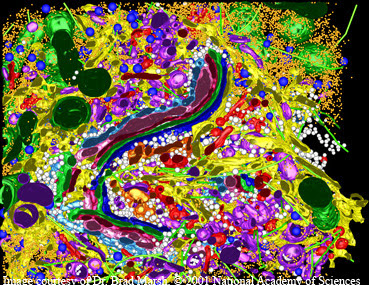Últimos assuntos
Tópicos mais visitados
Tópicos mais ativos

Preparando a próxima geração de biólogos moleculares: a complexidade da maquinaria celular
Página 1 de 1
09012011

 Preparando a próxima geração de biólogos moleculares: a complexidade da maquinaria celular
Preparando a próxima geração de biólogos moleculares: a complexidade da maquinaria celular
Preparando a próxima geração de biólogos moleculares: a complexidade da maquinaria celular
Sábado, Janeiro 08, 2011
Cell, Vol. 92, 291–294, February 6, 1998, Copyright 998 by Cell Press
The Cell as a Collection of Protein Machines: Preparing the Next Generation of Molecular Biologists
Bruce Alberts
President, National Academy of Sciences
2101 Constitution Avenue NW
Washington, D.C. 20418
Professor, Department of Biochemistry and Biophysics
University of California, San Francisco
San Francisco, California 94143

Cell complexity - Dr. Brad Marsh - National Academy of Sciences
Image not related to this article/Imagem não relacionada a este artigo
Introduction
We have always underestimated cells. Undoubtedly we still do today. But at least we are no longer as naive as we were when I was a graduate student in the 1960s. Then, most of us viewed cells as containing a giant set of second-order reactions: molecules A and B were thought to diffuse freely, randomly colliding with each other to produce molecule AB—and likewise for the many other molecules that interact with each other inside a cell. This seemed reasonable because, as we had learned from studying physical chemistry, motions at the scale of molecules are incredibly rapid. Consider an enzyme, for example. If its substrate molecule is present at a concentration of 0.5 mM, which is only one substrate molecule for every 105 water molecules, the enzyme's active site will randomly collide with about 500,000 molecules of substrate per second. And a typical globular protein will be spinning to and fro, turning about various axes at rates corresponding to a million rotations per second.
But, as it turns out, we can walk and we can talk because the chemistry that makes life possible is much more elaborate and sophisticated than anything we students had ever considered. Proteins make up most of the dry mass of a cell. But instead of a cell dominated by randomly colliding individual protein molecules, we now know that nearly every major process in a cell is carried out by assemblies of 10 or more protein molecules. And, as it carries out its biological functions, each of these protein assemblies interacts with several other large complexes of proteins. Indeed, the entire cell can be viewed as a factory that contains an elaborate network of interlocking assembly lines, each of which is composed of a set of large protein machines.
Consider, as an example, the cell cycle–dependent degradation of specific proteins that helps to drive a cell through mitosis. First a large complex of about 10 proteins, the anaphase-promoting complex (APC), selects out a specific protein for polyubiquitination ([11 and 22]); this protein is then targeted to the proteasome's 19S cap complex formed from about 20 different subunits; and the cap complex then transfers the targeted protein into the barrel of the large 20S proteasome itself, where it is finally converted to small peptides ( [5] [this issue).
...
+++++
FULL FREE PDF COMPLETO GRÁTIS
+++++
NOTA DESTE BLOGGER:
Bruce Alberts não defende as teses da teoria do Design Inteligente, mas é interessante destacar aqui que Michael Behe levantou esta questão de complexidade irredutível em sistemas biológicos em 1996, e Alberts comparou esta complexidade celular a uma fábrica.
E ainda têm a cara de pau de dizer que sinais de inteligência não são detectados na natureza. Olhe uma 'simples' célula e veja design inteligente em cada de nível de complexidade. Aliás, é o que os cientistas estão cada vez mais encontrando -- camadas e camadas de extrema complexidade.
Sábado, Janeiro 08, 2011
Cell, Vol. 92, 291–294, February 6, 1998, Copyright 998 by Cell Press
The Cell as a Collection of Protein Machines: Preparing the Next Generation of Molecular Biologists
Bruce Alberts
President, National Academy of Sciences
2101 Constitution Avenue NW
Washington, D.C. 20418
Professor, Department of Biochemistry and Biophysics
University of California, San Francisco
San Francisco, California 94143

Cell complexity - Dr. Brad Marsh - National Academy of Sciences
Image not related to this article/Imagem não relacionada a este artigo
Introduction
We have always underestimated cells. Undoubtedly we still do today. But at least we are no longer as naive as we were when I was a graduate student in the 1960s. Then, most of us viewed cells as containing a giant set of second-order reactions: molecules A and B were thought to diffuse freely, randomly colliding with each other to produce molecule AB—and likewise for the many other molecules that interact with each other inside a cell. This seemed reasonable because, as we had learned from studying physical chemistry, motions at the scale of molecules are incredibly rapid. Consider an enzyme, for example. If its substrate molecule is present at a concentration of 0.5 mM, which is only one substrate molecule for every 105 water molecules, the enzyme's active site will randomly collide with about 500,000 molecules of substrate per second. And a typical globular protein will be spinning to and fro, turning about various axes at rates corresponding to a million rotations per second.
But, as it turns out, we can walk and we can talk because the chemistry that makes life possible is much more elaborate and sophisticated than anything we students had ever considered. Proteins make up most of the dry mass of a cell. But instead of a cell dominated by randomly colliding individual protein molecules, we now know that nearly every major process in a cell is carried out by assemblies of 10 or more protein molecules. And, as it carries out its biological functions, each of these protein assemblies interacts with several other large complexes of proteins. Indeed, the entire cell can be viewed as a factory that contains an elaborate network of interlocking assembly lines, each of which is composed of a set of large protein machines.
Consider, as an example, the cell cycle–dependent degradation of specific proteins that helps to drive a cell through mitosis. First a large complex of about 10 proteins, the anaphase-promoting complex (APC), selects out a specific protein for polyubiquitination ([11 and 22]); this protein is then targeted to the proteasome's 19S cap complex formed from about 20 different subunits; and the cap complex then transfers the targeted protein into the barrel of the large 20S proteasome itself, where it is finally converted to small peptides ( [5] [this issue).
...
+++++
FULL FREE PDF COMPLETO GRÁTIS
+++++
NOTA DESTE BLOGGER:
Bruce Alberts não defende as teses da teoria do Design Inteligente, mas é interessante destacar aqui que Michael Behe levantou esta questão de complexidade irredutível em sistemas biológicos em 1996, e Alberts comparou esta complexidade celular a uma fábrica.
E ainda têm a cara de pau de dizer que sinais de inteligência não são detectados na natureza. Olhe uma 'simples' célula e veja design inteligente em cada de nível de complexidade. Aliás, é o que os cientistas estão cada vez mais encontrando -- camadas e camadas de extrema complexidade.

Eduardo- Mensagens : 5997
Idade : 54
Inscrição : 08/05/2010
Preparando a próxima geração de biólogos moleculares: a complexidade da maquinaria celular :: Comentários
Nenhum comentário
 Tópicos semelhantes
Tópicos semelhantes» Os biólogos evolucionários estão fazendo controle de danos com a teoria da evolução???
» Maquinaria sofisticada
» Relógios moleculares são confiáveis?
» A inutilidade dos relógios moleculares
» Máquinas moleculares inspiram cientistas
» Maquinaria sofisticada
» Relógios moleculares são confiáveis?
» A inutilidade dos relógios moleculares
» Máquinas moleculares inspiram cientistas
Permissões neste sub-fórum
Não podes responder a tópicos
 Início
Início








 Seja fã Forumeiros
Seja fã Forumeiros
» Acordem adventistas...
» O que Vestir Para Ir à Igreja?
» Ir para o céu?
» Chat do Forum
» TV Novo Tempo...
» Lutas de MMA são usadas como estratégia por Igreja Evangélica para atrair mais fiéis
» Lew Wallace, autor do célebre livro «Ben-Hur», converteu-se quando o escrevia
» Ex-pastor evangélico é batizado no Pará
» Citações de Ellen White sobre a Vida em Outros Planetas Não Caídos em Pecado
» Viagem ao Sobrenatural - Roger Morneau
» As aparições de Jesus após sua morte não poderiam ter sido alucinações?